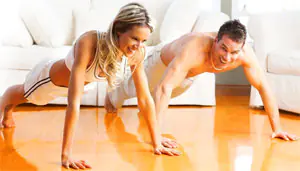Do you think quality bodybuilding exercises at home are a myth? Believe me, not at all. A pair of collapsible dumbbells, a gymnastic bench - and a small but completely real gym will magically appear in the corner of your apartment. This comprehensive article will tell you how to use it, how to pump up your body at home - read on and become a home bodybuilding guru.
I don’t argue that it’s unlikely that you will be able to prepare for Olympia at home; without special simulators, you can’t pump up your muscles in isolation to clearly separate them. But you will undoubtedly gain good mass and remarkable strength. And now I’ll explain why...
- Firstly, exercises with dumbbells are performed along natural trajectories, freely, with the involvement of many associated muscles. They equally develop muscle mass and strength, and improve coordination of movements. You are in complete control of the training process, changing the pace and amplitude of exercises as you wish.
- Secondly, training with dumbbells is the safest type of “pumping”; the risk of injury is minimal, especially for the wrists and hands. No forced absences from training due to discomfort.
- Thirdly, dumbbells will provide you with symmetrical development, since you will inevitably have to pull up your lagging arm or weaker delta. And even a barbell cannot fully guarantee this!
Now let's move on directly to training. If you are not in a hurry, and summer is still far away, then try a long-term program designed for 20 weeks. It consists of 3 cycles. And in 5 months you will surprise everyone.
Before starting classes, do not forget about a light aerobic warm-up. Select the weight of the dumbbells so that the recommended number of repetitions is the maximum.
Cycle 1. First 6 weeks.
- Standing dumbbell lift. We start with 3 series of 12-15 repetitions. The same rule applies to subsequent exercises.
- Alternate lunges. In the starting position, standing with dumbbells in straightened arms, we step forward with one leg to a half-squat, the second leg remains in place.
- Lifting weights in a standing position to the chin.
- Crunches or regular sit-ups from a bench. It’s good if your partner fixes your legs.
- Bench press.
- Squats. We hold dumbbells in our hands, strictly watch our backs, and don’t hunch over.
- Dumbbell biceps press with each hand in turn.
- French press standing behind your head.
- Lifting dumbbells to the chin.
- Alternate lunges.
- Bent over dumbbell raise. We rest our hand and knee on the bench, and with the other hand we pull the dumbbell to the lower abdomen. We try to perform the movement using the efforts of the back muscles, moving the shoulder back.
- Twisting.
- Dumbbell bench press on an incline bench.
- “Hammer” on the biceps of the arms.
- Squats.
- Deadlift.
- Standing French press.
Cycle 2. Weeks No. 7-12.
We slightly increase the weights, perform the movements in 4 series of 10 repetitions. The frequency of training also increases.
- Seated press.
- Raising your arms to the sides while sitting.
- Bent over dumbbell raise.
- Bench press.
- Raising your arms while lying on a bench.
- Seated biceps exercise. You can use the Hummer option.
- French bench press.
- Straightening your arms while bending over. We press the elbow to the body, using the triceps force, we straighten the arm from the dumbbells.
- Squats.
- Lunges.
- Classic deadlift.
- Standing toe raise.
- Simultaneous rise on toes with a load while sitting.
- Twisting.
- Body tilts.
Cycle 3. Weeks No. 13-20.
We also increase the weights, leaving the number of approaches for each exercise at 4-5, the number of repetitions per set at 7-9, with the exception of crunches. They are still performed without weights 15 times.
- Standing press.
- Bent over arms raises. The back is straight, you can rest your forehead on the bench.
- Bent over row.
- Incline bench press.
- Concentrated dumbbell lift while sitting, resting your elbow on the inner thigh.
- Alternating biceps curl.
- Standing French press.
- Straightening your arms while bending over.
- Squats.
- Lunges.
- Deadlift.
- Standing on the toe of one leg.
- Seated calf raise with weights.
- Twisting.
- Raising legs from a hanging position. Perform without weights 15 times.

There are other, more compact programs designed for quick results. They include basic exercises only for the main muscles. And pumping up your body at home with their help is also quite possible. For example, here is a complex:
- Bench press;
- Bent-over dumbbell row;
- Squeezing dumbbells from the shoulders while sitting;
- Squats;
- Deadlift;
- Biceps curl;
- French press;
- Abdominal crunches or crunches.
Change the number of approaches and repetitions, as well as the weight of gymnastic equipment, similarly to the long-term program as your fitness increases.



